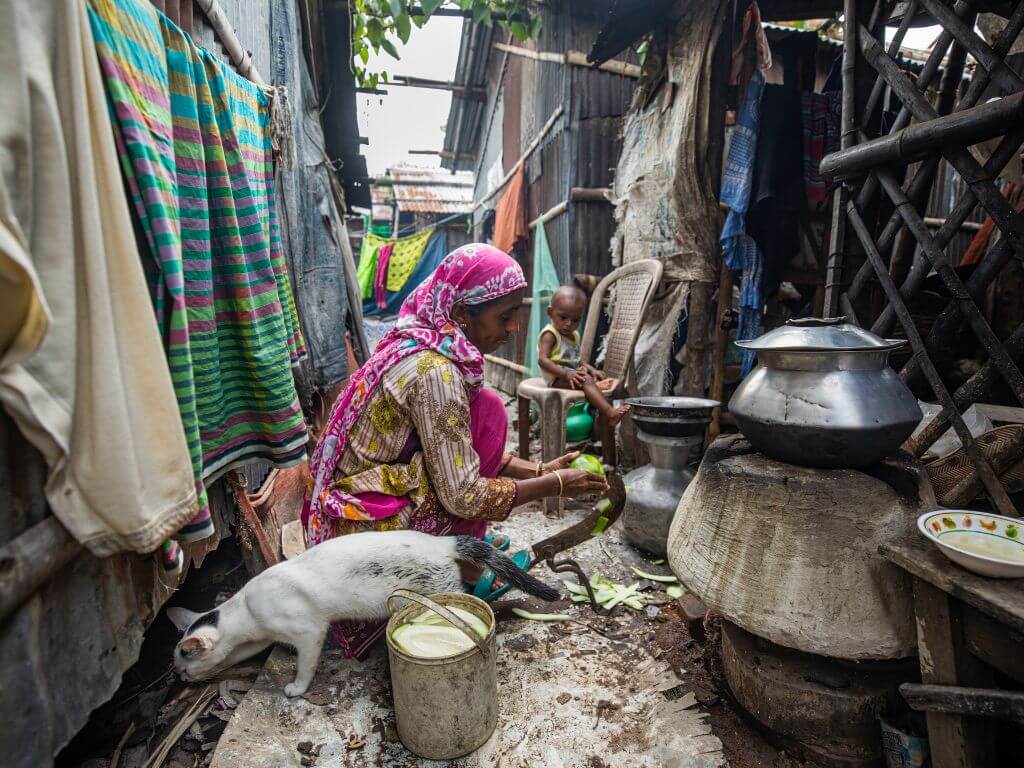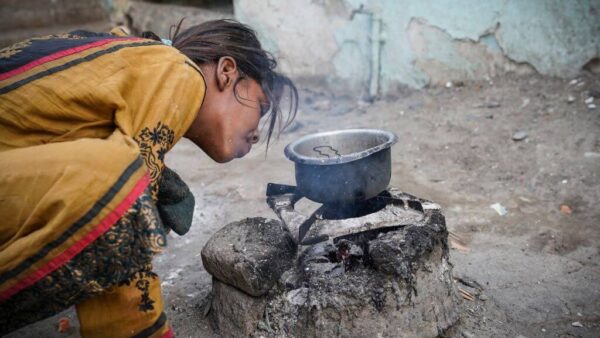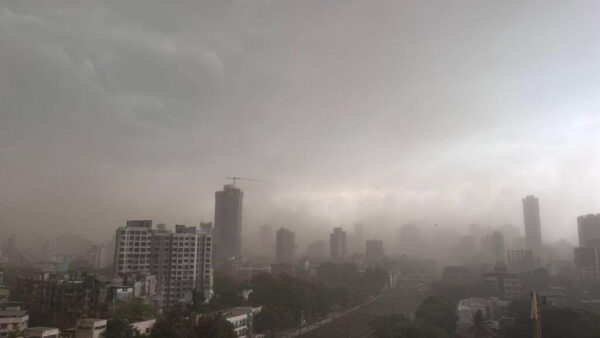Climate justice : Justice that links development and human rights to achieve a human-centred approach to addressing climate change, safeguarding the rights of people in situations of vulnerability, and sharing the burdens and benefits of climate change and its impacts equitably and fairly.
Inequity and injustice are at the root and the heart of the climate crisis. Nowhere is this starker and more evident than in our cities. As heat waves after heat waves scorch cities across South Asia, there is a difference of at least 20 degrees Celsius between the air conditioned apartments of the rich in the high-rise buildings and the tin sheds of the poor in the slums of our cities, as this paper[1] shows. The replacement of trees and vegetation with asphalt and concrete for buildings, roads, and other structures, along with waste heat from cars, factories and air conditioners, result in metropolitan areas that are up to 20 degrees Celsius warmer[2] than their surroundings.
The urgent need for centering climate justice in all future decision-making processes has been the main purpose and thrust of the in-depth essays and stories written for QoC-CANSA Fellowship on cities and climate change that have been featured over the past few months. This work – from Delhi, Dhaka, Guwahati, Hyderabad, Karachi and Kathmandu – graphically illustrate the uneven and unequal impact of climate change on the urban poor, especially the informal workers living in informal settlements or slums to eke out a living while ill-equipped to face the onslaught of repeated heatwaves, floods, or pandemics.
Asia remained the world’s most disaster-hit region from weather, climate and water-related hazards in 2023.[3] Floods and storms caused the highest number of reported casualties and economic losses, whilst the impact of heatwaves became more severe, according to a new report from the World Meteorological Organization (WMO). As shown by last year’s heat waves that affected over 1 billion people in India and Pakistan[4], the region’s acute vulnerabilities to rising temperatures and frequency, duration, and intensity of extreme heat events pose a climate challenge to deal with now rather than in the distant future.
The climate emergency we face in South Asia today may have its roots in colonialism and global capitalism, however its ability to exacerbate historical injustices and perpetuate new ones, is most visible through the accelerated processes of capital-focused urbanisation, the growth of the urban population, the systematic destruction of natural ecology and the exponential increase of capital accumulation and consumption in cities. It is worth remembering that cities emit up to 75 per cent of global greenhouse gas emissions[5] and often serve as the economic engines of their respective nations.

Photo: Saqlain Rizve
Nearly 2.5 billion people that live in urban areas in South Asia have limited capacity to adapt to climate change and lack climate resilience. Of this, more than a billion people in informal settlements are extremely vulnerable to natural hazards because of poor socio-economic, environmental and infrastructure conditions. While cities face the climate change impacts, these are not evenly spread across all the millions who live in them – poorer people and informal communities are more vulnerable to extreme weather events which impact their lives and livelihoods that mostly tether on the edge. Widespread thermal inequities exist within cities, so do large inequities during and after floods.
For instance, Bangladesh recorded its worst outbreak of dengue last year. The poor were more susceptible as they lived in areas with compromised sanitation which worsens the vector-borne disease already worsened by heat waves and flash floods. And women bore the brunt. With studies predicting a 1.13-times increase in dengue cases if the maximum temperature rises by even 1 degree Celsius, the country’s healthcare is inextricably linked to its climate response, as this story showed.[6]
To make matters worse, within these populations in situations of vulnerability there are several aspects that affect certain groups more than others. For example, women, girls and people who identify as LGBTQI are more likely to experience violence, discrimination or everyday inequalities; the homeless, who are continuously exposed to adverse weather conditions, pollution and poor food, hygiene and health; children and the elderly, who suffer the consequences of climate change the most; people that have historically been, and continue to be, discriminated against because of their caste, ethnic group, income, physical abilities or social status; and those who live by undertaking informal jobs, depend on daily wages and have no social assistance of any kind.
In the sweltering heat of India’s capital New Delhi, the lives of millions of urban poor were turned upside down by the ruthless demolitions carried out first for the ‘beautification drive’ for the G20 Summit and later to tackle floods. The national capital does not have a functional Heat Action Plan, which aggravates the problems arising out of extreme weather events, as this ground report by QoC-CANSA Fellows showed.[7]

Photo: Hrushikesh Patil
The bulk of the future demographic growth is predicted to happen in secondary cities of the Global South, in informal and poorly planned neighbourhoods. By 2050, billions more urban dwellers will be left struggling to cope with the impacts of climate hazards, with impacts felt well beyond the confines of urban slums. Cities are suffering from the impacts of planning systems that fail to keep up with rampant urbanisation. To illustrate, a change in rainfall pattern has made Guwahati more flood-prone over the years even as the city’s outdated drainage system, which was not designed to carry a high volume of water, contributes to the severe flooding every year.[8]
As cities in South Asia are expected to welcome more than 200 million new residents (or about the entire population of Pakistan) by 2030[9] and with most of the urban infrastructure of 2050 yet to be built[10], policymakers in the region need to plan for a progressively both urban and warmer future. The impact of climate-induced catastrophes doubles in Pakistani women as they are left out of the decision-making policies. However, as this essay[11] shows, women living in informal settlements in Karachi are gradually realising that the fight against climate change is solely theirs. For a country deeply rooted in gender disparity, this means many challenges.

Photo: Zofeen T Ebrahim
Cities are central to the delivery of the climate commitments of the Paris Agreement and Sustainable Development Goals. Ensuring climate justice for the urban poor, who are at the front line, will be critical to their well-being and livelihoods. Addressing urban inequality and informality is a major way for building city resilience, unlocking mitigation potential, and making urbanisation sustainable for all. Resilient and sustainable urban communities rely on quality, safe and affordable basic services, such as water, sanitation, hygiene, and energy in cities.
Conversely, their chronic or sudden disruption undermines resilience. In slums with poor or no access to basic services, climate change multiplies and increases risks to safety, health, and livelihoods. Dhaka, the capital of Bangladesh and also the world’s most dense city with 44,500 people per square kilometre, has between a thousand and 2,000 migrating to the city every day in search of work. Without proper shelter, they are forced to bear the impact of urban flooding and heat waves which have been exacerbated by climate change.[12]
Subnational and local governments are “key enablers of a just transition”[13] on the frontlines of the climate crisis with often greater legitimacy and competence to oversee context specific environmental transitions well-attuned to local needs. Over the past two decades, cities have increased their efforts to address climate change. However, examples of integrated policies of urban planning and management, centred around local climate risks and the lives of the urban poor are still missing. Climate impacts are felt and best understood at the local level which is why it is critical to facilitate decentralised adaptation by creating flexible adaptation funds operating at national and sub-national levels that can be drawn on by local governments and communities.

Photo: Dipen Dhungana
Long-term resilience for South Asian cities will require large and immediate investments in climate vulnerable areas and sectors. This calls for public investments that also achieve the vital co-benefits of creating jobs and increasing welfare. Accessing financing for climate resilience projects remains a challenge for many cities and unlocking private investment in climate resilience and adaptation has proven difficult. Greater domestic resource mobilisation must complement increased support from the international community. The story[14] from Melamchi, 76 kilometres from Nepal’s capital Kathmandu which bounced back from the massive 2015 earthquake when the flood in 2021 brought further devastation, underscored why the need for a comprehensive Climate Action plan is more urgent than ever.
Clearly, it is absolutely essential to engage poor and vulnerable communities in decision-making through inclusive participatory processes. Energy transitions, managed retreat and reskilling will have significant implications on the lives of millions in South Asia, and must be undertaken with full participation and consensus of those directly and most impacted. As the UN report, ‘Environmental Rights Brief, Climate Justice in Southeast Asia,’ states, “Climate justice requires climate solutions grounded in human rights, equality and non-discrimination and the participation of those most affected. This must include accountability for polluters, redress for victims, and protection of the vulnerable in all prevention, response, mitigation and remedial measures.”[15]
Finally, let’s not forget that cities can be the key agents of change in addressing the climate crisis, being “natural” sites for innovative and experimental climate action in a progressive direction. To fully leverage cities’ potential as agents of change, they must thus be “justice-aware” when developing climate policies.
Shailendra Yashwant is an environmental journalist, documentary photographer, and campaigns consultant based in India. He works on climate change-related mitigation, adaptation and projects and policy-making initiatives at national and international levels. He is a Senior Advisor to Climate Action Network South Asia (CANSA) and a steering committee member of the Pesticide Action Network (India).
Cover photo: Rajib Dhar




